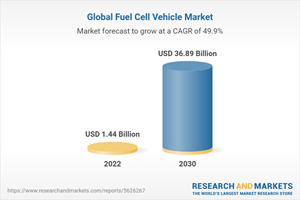Insights on the Fuel Cell Vehicle Global Market to 2030 - Players Include Daimler, Honda Motors, Nikola and Hyundai Motor Among Others

Global Fuel Cell Vehicle Market

Dublin, July 22, 2022 (GLOBE NEWSWIRE) -- The "Global Fuel Cell Vehicle Market Size, Share & Trends Analysis Report by Vehicle type (Passenger Cars, LCV's, HCV's), by Component, by Region, and Segment Forecasts, 2022-2030" report has been added to ResearchAndMarkets.com's offering.
The global fuel cell vehicle market size is expected to reach USD 36.89 billion by 2030 with a CAGR growth of 49.9% in the forecast period.
Factors such as strict environmental laws, the availability of incentives and subsidies for clean fuels, and hazardous gas emissions from combustion engine are the key drivers driving the global growth of the fuel cell vehicle market. Vehicle emissions have a negative influence on the environment and human life, and several government agencies have enacted rigorous emission regulations.
As long as regulatory rules are met, fuel cell vehicles will be in high demand. The growing awareness among manufacturers of the damage caused by car emissions on the environment and the development of alternative powertrains is fueling the market growth.
The government's major goal in developed countries is to develop and install hydrogen refueling stations. The government's primary goal in developing countries is to design a strategic plan for the commercial roll-out of fuel cell technology. Therefore, the urgent need for infrastructure investment is another aspect driving market growth. To boost the market growth for the fuel cell vehicle market, several countries such as Australia, Canada and South Korea are aiming for a full range of hydrogen filling stations across the world.
Although, fuel cell vehicles are expensive and hydrogen (per kilo) is expensive in some locations, these reasons are impeding the growth of the fuel cell vehicle market. It is a scalable and adaptable electrical source for big transportation applications such as material handling trucks, buses, railroads, defense vehicles, and light commercial vehicles (LCVs). In commercial applications, it is also employed as a stationary fuel source. Furthermore, rising government attempts to promote fuel cells for transportation provide the potential for the fuel cell vehicle market to develop.
The North America and Asia Pacific is expected to witness positive market growth owing to the increased adoption of passenger and commercial electric vehicles. The markets are experiencing strong advocacy to make fuel cell vehicles mainstream due to its positive impact on the environment. The government in the Asia Pacific are also promoting the uptake of fuel cell vehicle by providing subsidies to the buyers. Thus, propelling the market growth.
Report Highlights:
The market is expected to register growth due to increased crude oil prices and increasing concentration of carbon emission.
The governments of developed and developing countries are actively investing in fuel cell technology and infrastructure.
The passenger car segment is expected to witness growth owing to extensive usage for commuting and supply chain purpose.
The industry's progress is limited by a failing distribution network, fear of electric shock, and flammability owing to the chemical attribute of hydrogen fuel cells, which act as a limitation on the market's growth.
Key Topics Covered:
Chapter 1 Methodology and Scope
Chapter 2 Executive Summary
Chapter 3 Fuel Cell Vehicle Market Analysis Market Variables, Trends & Scope
3.1 Penetration and Growth Prospect Mapping
3.2 Fuel Cell Vehicle Market Dynamics
3.2.1 Market Driver Analysis
3.2.2 Market Restraints Analysis
3.3 Industry Value Chain Analysis
3.4 Market Analysis Tools
3.4.1 Industry Analysis-PORTER's Five Forces Analysis
3.4.2 PEST Analysis
3.5 Fuel Cell Vehicle Market Key Company Analysis, 2021
3.6 Impact Of COVID-19 On Fuel Cell Vehicle Market
Chapter 4 Fuel Cell Vehicle Analysis Market: By Vehicle Type Outlook
4.1 Market Size Estimates & Forecasts And Trend Analysis, 2018-2030 (Revenue, USD Million)
4.2 Passengers cars
4.2.1 Market Estimates and Forecasts By region, 2018-2030 (Revenue, USD Million)
4.3 LCV's
4.3.1 Market Estimates and Forecasts By region, 2018-2030 (Revenue, USD Million)
4.4 HCV's
4.4.1 Market Estimates and Forecasts By region, 2018-2030 (Revenue, USD Million)
Chapter 5 Fuel Cell Vehicle Analysis Market: Regional Outlook
Chapter 6 Competitive Landscape
6.1 Daimler AG
6.1.1 Company Overview
6.1.2 Financial Performance
6.1.3 Product Benchmarking
6.1.4 Recent Developments
6.2 Honda Motors Co. Ltd.
6.2.1 Company Overview
6.2.2 Financial Performance
6.2.3 Product Benchmarking
6.2.4 Recent Developments
6.3 Nikola Corporation
6.3.1 Company Overview
6.3.2 Financial Performance
6.3.3 Product Benchmarking
6.3.4 Recent Developments
6.4 Toyota Motor Corporation
6.4.1 Company Overview
6.4.2 Financial Performance
6.4.3 Product Benchmarking
6.4.4 Recent Developments
6.5 Hyundai Motor Group
6.5.1 Company Overview
6.5.2 Financial Performance
6.5.3 Product Benchmarking
6.5.4 Recent Developments
6.6 Ballard Power System Inc.
6.6.1 Company Overview
6.6.2 Financial Performance
6.6.3 Product Benchmarking
6.6.4 Recent Developments
6.7 Volvo AB
6.7.1 Company Overview
6.7.2 Financial Performance
6.7.3 Product Benchmarking
6.7.4 Recent Developments
6.8 General Motors
6.8.1 Company Overview
6.8.2 Financial Performance
6.8.3 Product Benchmarking
6.8.4 Recent Developments
6.9 BMW AG
6.9.1 Company Overview
6.9.2 Financial Performance
6.9.3 Product Benchmarking
6.9.4 Recent Developments
6.10 Audi AG
6.10.1 Company Overview
6.10.2 Financial Performance
6.10.3 Product Benchmarking
6.10.4 Recent Developments
For more information about this report visit https://www.researchandmarkets.com/r/jmgkpl
Attachment
CONTACT: CONTACT: ResearchAndMarkets.com Laura Wood, Senior Press Manager press@researchandmarkets.com For E.S.T Office Hours Call 1-917-300-0470 For U.S./CAN Toll Free Call 1-800-526-8630 For GMT Office Hours Call +353-1-416-8900


 Yahoo Finance
Yahoo Finance 
